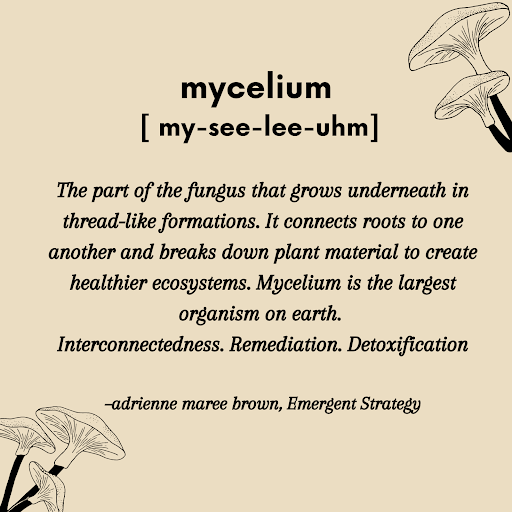Mapping Mycelium: Series Introduction
February 15, 2021
Editor’s Note: All columns published by The Daily Barometer do not represent the opinion of The Baro, rather, columns reflect the personal opinions of the writer.
Mapping Mycelium: Sowing Stories of Resistance
If I told you that key movement strategies lie below our feet, would you believe me? Now I’m no botanist, but mycelium–meaning more than one—can give insight into how we build community, heal generationally and create collective change.
In nature, everything works together and there is deep collaboration from all beings to survive. Moss, lichen, fungi, trees and roots are all connected to each other and create life and possibility beyond language, time and generation. The roots of the forest floor share knowledge and guidance in the movement for change and liberation.
Nature’s wonders open us up to deeper lessons and understanding of how we as humans can reconnect to our own root systems and see nature as kin who demonstrate survival and adaptation. With respect, gratitude and care, we can receive abundant gifts from nature; movement tools and strategies.
Mycelium are underground networks that link plants together and send signals back and forth to each other. As mycelium extend outwards, they build symbiotic relationships of growth between them and nearly all plant life. These tight connections in nature shows how mycelium can provide a map of how our collective desire for change is felt and heard across communities. What gives me hope is that there are others that I have not yet met making radical changes and resisting the powers that constrict and constrain our inner light. Mycelium shows us that if we extend our own words and hands to others, we will feel a lot less isolated in doing movement work.
Organizers across borders have historically connected and shared stories with others who are fighting for justice as we are all rooted in the belief that we can build a future outside of the limits that surround us. Together we are able to envision an equitable and healing centered movement that works towards Indigenous sovereignty, reparations and anti-racist practices. We build relationships with one another to survive and fight white supremacy just as plants depend on one another to live.
For instance, moss are great models of resiliency and community care. Moss plants are community oriented, using the nearness of others to create a network of shoots and leaves that intertwine to absorb and hold moisture for the area it surrounds. Moss demonstrates the necessity of connection in order to survive and work collectively to keep those around them alive. If we’re able to see the ways that we are connected and belong to a community that works together to survive, the stronger our movements and power will be.
Robin Wall Kimmerrer, mother, scientist, decorated professor, enrolled member of the Citizen Potawatomi Nation and author of Braiding Sweetgrass and Gathering Moss, writes beautifully about the interconnectedness of plants and other beings. In her book, Gathering Moss, she makes this point about how, “If mosses are to take their place in the recovering forest, they must be granted a refuge that will sustain them. If given a voice, I think they would advocate for patches large enough to hold moisture, shady enough to nurture their entire community.” (Gathering Moss 2003). Just like moss, Black, Indigenous, people of color, queer & disabled folks organizers want to live in a place where we are able to thrive and share that care with our community members.
From listening to Eastern Oregon Black Lives Matter organizers, to youth around Oregon rising against racism—each story of change in Oregon will be connected through our mycelium of liberation. We separate ourselves in counties and behind invisible borders that train us to distrust one another, largely due to the history of this state. While Oregon can be seen as a liberal haven, that is far from reality. Understanding that Oregon’s history is rooted in Black exclusion, Indigenous genocide and was “established” to be a white utopia are key pieces in seeing how the current systems in place were always meant to uphold white supremacy.
Through my conversations with people across Oregon who are fighting for justice, I’ve realized that what moves movements forward are the people and communities who work together to create ecosystems of community care. Not everyone highlighted in this series may agree with each other or utilize the same tactics and strategies; my hope is that you take the lessons you need and continue to be a seed of change, and blooming into the worlds we are imagining, disrupting, teaching, creating, learning and loving. May we each tap into the mycelium of liberation and continue to be the seeds that continue to grow as change.


















































































![Newspaper clipping from February 25, 1970 in the Daily Barometer showing an article written by Bob Allen, past Barometer Editor. This article was written to spotlight both the student body’s lack of participation with student government at the time in conjunction with their class representatives response. [It’s important to note ASOSU was not structured identically to today’s standards, likely having a president on behalf of each class work together as one entity as opposed to one president representing all classes.]](https://dailybaro.orangemedianetwork.com/wp-content/uploads/2025/03/Screenshot-2025-03-12-1.00.42-PM-e1741811160853.png)
























